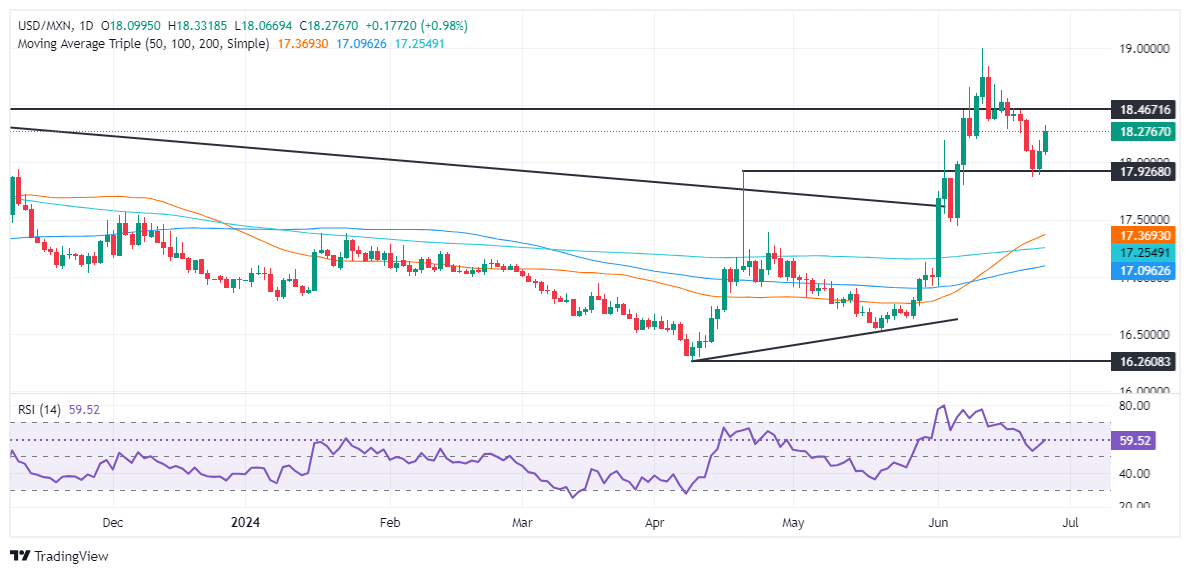Most recent article: Mexican Peso takes a break after two-day decline ahead of Banxico meeting
- Mexican Peso falls for second consecutive day against US Dollar.
- USD/MXN hits a daily high of 18.36 before trimming gains as Wall Street turns green.
- Banxico expected to keep interest rates unchanged at 11.00% amid sharp Peso depreciation and recent inflation spike.
- Fed Governor Michelle Bowman's hawkish comments support USD.
The Mexican Peso extended its losses for the second consecutive day against the Greenback after the latter rose sharply. This was boosted by the jump in the USD/JPY pair, which exchanges hands at 38-year high as US Treasury bond yields advance as traders brace for the release of crucial inflation data in the United States (US). The USD/MXN trades at 18.33, up 1.30 %.
Sentiment shifted positively as Wall Street turned green during the last hour, trimming the USD/MXM pair gains after hitting a daily high of 18.33. Mexico’s economic docket remains scarce as investors brace for Thursday's Bank of Mexico (Banxico) monetary policy.
Banxico is expected to keep interest rates unchanged at 11.00% after the Mexican currency experienced a sharp depreciation following the June 2 election, alongside the sudden jump in June’s mid-month inflation.
The Citibanamex survey showed that most economists expect rates to be unchanged at 11.00%, yet they expect the central bank to cut rates until August.
Besides that, investors are eyeing President-elect Claudia Sheinbaum’s cabinet members on Thursday.
Meanwhile, the USD/MXN experienced back-to-back positive gains sponsored by Federal Reserve (Fed) officials' hawkish comments, particularly Governor Michelle Bowman. She said that rates will remain steady for “some time” and that if the disinflation process stalls, she’s open to another interest rate hike.
Daily digest market movers: Mexican Peso falls as traders await Banxico decision
- Mexico’s economic docket will feature the Balance of Trade for May on Thursday, alongside the Unemployment Rate.
- Citibanamex survey showed economists priced out fewer rate cuts by the central bank, estimating rates will be lowered to 10.25% in 2024, up from 10.00%. Regarding the USD/MXN, the consensus estimates the exchange rate will end the year at 18.70, up from 18.00 in the previous report.
- Regarding economic growth, the consensus revised the Gross Domestic Product (GDP) for 2024 downward from 2.2% to 2.1% YoY.
- CME FedWatch Tool shows odds for a 25-basis-point Fed rate cut at 56.3%, lower than Tuesday’s 59.5%.
Technical analysis: Mexican Peso falls as USD/MXN rallies back above 18.20
The USD/MXN uptrend remains in play, but the exotic pair will remain volatile during the rest of the session and Thursday as traders await Banxico’s decision. Momentum favors buyers, according to the Relative Strength Index (RSI), is bullish.
For a bullish continuation, buyers need to push the USD/MXN exchange rate past the psychological 18.50 level. Once cleared, the next stop would be the year-to-date (YTD) high of 18.99, followed by the March 20, 2023, high of 19.23, followed by an uptick to 19.50.
On the flip side, if USD/MXN tumbles below 18.00, the next key support level would be the 50-day Simple Moving Average (SMA) at 17.37 before testing the 200-day SMA at 17.23. Once those two levels are cleared, the next stop would be the 100-day SMA at 17.06.
Mexican Peso FAQs
The Mexican Peso (MXN) is the most traded currency among its Latin American peers. Its value is broadly determined by the performance of the Mexican economy, the country’s central bank’s policy, the amount of foreign investment in the country and even the levels of remittances sent by Mexicans who live abroad, particularly in the United States. Geopolitical trends can also move MXN: for example, the process of nearshoring – or the decision by some firms to relocate manufacturing capacity and supply chains closer to their home countries – is also seen as a catalyst for the Mexican currency as the country is considered a key manufacturing hub in the American continent. Another catalyst for MXN is Oil prices as Mexico is a key exporter of the commodity.
The main objective of Mexico’s central bank, also known as Banxico, is to maintain inflation at low and stable levels (at or close to its target of 3%, the midpoint in a tolerance band of between 2% and 4%). To this end, the bank sets an appropriate level of interest rates. When inflation is too high, Banxico will attempt to tame it by raising interest rates, making it more expensive for households and businesses to borrow money, thus cooling demand and the overall economy. Higher interest rates are generally positive for the Mexican Peso (MXN) as they lead to higher yields, making the country a more attractive place for investors. On the contrary, lower interest rates tend to weaken MXN.
Macroeconomic data releases are key to assess the state of the economy and can have an impact on the Mexican Peso (MXN) valuation. A strong Mexican economy, based on high economic growth, low unemployment and high confidence is good for MXN. Not only does it attract more foreign investment but it may encourage the Bank of Mexico (Banxico) to increase interest rates, particularly if this strength comes together with elevated inflation. However, if economic data is weak, MXN is likely to depreciate.
As an emerging-market currency, the Mexican Peso (MXN) tends to strive during risk-on periods, or when investors perceive that broader market risks are low and thus are eager to engage with investments that carry a higher risk. Conversely, MXN tends to weaken at times of market turbulence or economic uncertainty as investors tend to sell higher-risk assets and flee to the more-stable safe havens.
Information on these pages contains forward-looking statements that involve risks and uncertainties. Markets and instruments profiled on this page are for informational purposes only and should not in any way come across as a recommendation to buy or sell in these assets. You should do your own thorough research before making any investment decisions. FXStreet does not in any way guarantee that this information is free from mistakes, errors, or material misstatements. It also does not guarantee that this information is of a timely nature. Investing in Open Markets involves a great deal of risk, including the loss of all or a portion of your investment, as well as emotional distress. All risks, losses and costs associated with investing, including total loss of principal, are your responsibility. The views and opinions expressed in this article are those of the authors and do not necessarily reflect the official policy or position of FXStreet nor its advertisers. The author will not be held responsible for information that is found at the end of links posted on this page.
If not otherwise explicitly mentioned in the body of the article, at the time of writing, the author has no position in any stock mentioned in this article and no business relationship with any company mentioned. The author has not received compensation for writing this article, other than from FXStreet.
FXStreet and the author do not provide personalized recommendations. The author makes no representations as to the accuracy, completeness, or suitability of this information. FXStreet and the author will not be liable for any errors, omissions or any losses, injuries or damages arising from this information and its display or use. Errors and omissions excepted.
The author and FXStreet are not registered investment advisors and nothing in this article is intended to be investment advice.
Recommended content
Editors’ Picks

Gold surges to fresh record high above $3,400 Premium
Gold extends its uptrend and trades at a new all-time high above $3,400 on Monday. Concerns over a further escalation in the US-China trade war and the Fed’s independence smash the US Dollar to three-year troughs, fuelling XAU/USD's rally.

EUR/USD clings to strong gains near 1.1500 on persistent USD weakness
EUR/USD gains more than 1% on the day and trades at its highest level since November 2021 near 1.1500. The relentless US Dollar selling helps the pair push higher as fears over a US economic recession and the Federal Reserve’s autonomy grow.

GBP/USD tests 1.3400 as USD selloff continues
GBP/USD continues its winning streak, testing 1.3400 on Monday. The extended US Dollar weakness, amid US-Sino trade war-led recession fears and heightened threat to the Fed's independence, underpin the pair following the long weekend.

An ambush for the ages
The dollar continued to get sold going into last weekend, but not as badly as one would think given the bad economic reports on Thursday... The BBDXY ended the week at 1,224

Five fundamentals for the week: Traders confront the trade war, important surveys, key Fed speech Premium
Will the US strike a trade deal with Japan? That would be positive progress. However, recent developments are not that positive, and there's only one certainty: headlines will dominate markets. Fresh US economic data is also of interest.

The Best brokers to trade EUR/USD
SPONSORED Discover the top brokers for trading EUR/USD in 2025. Our list features brokers with competitive spreads, fast execution, and powerful platforms. Whether you're a beginner or an expert, find the right partner to navigate the dynamic Forex market.




